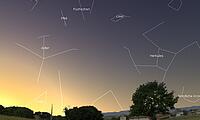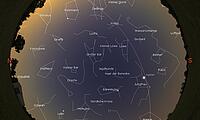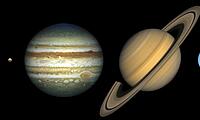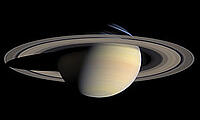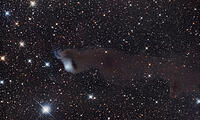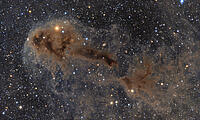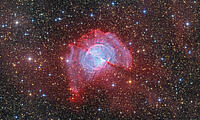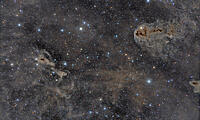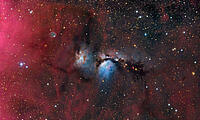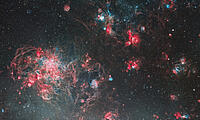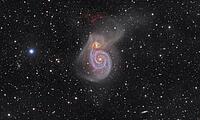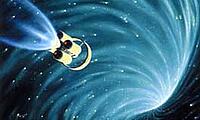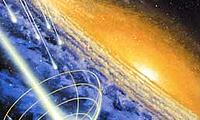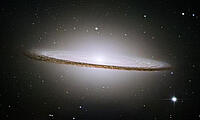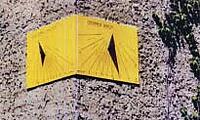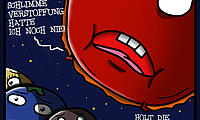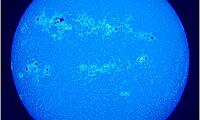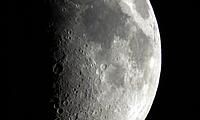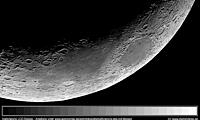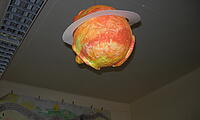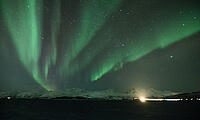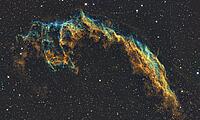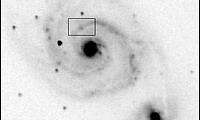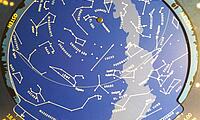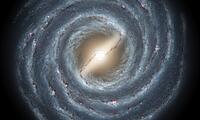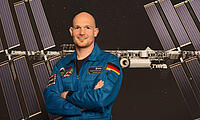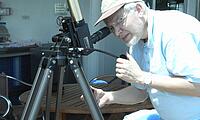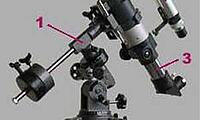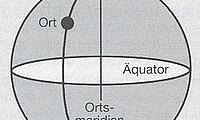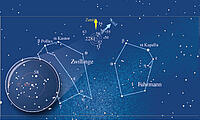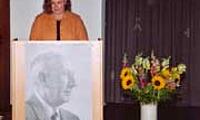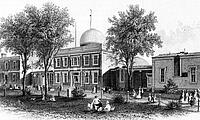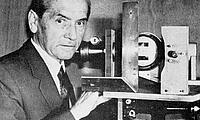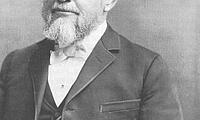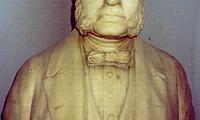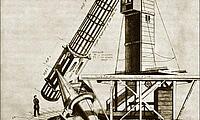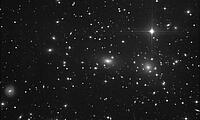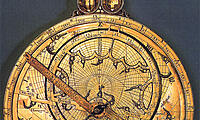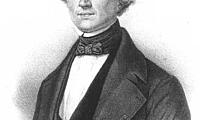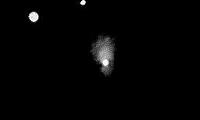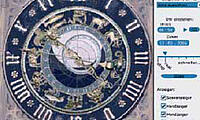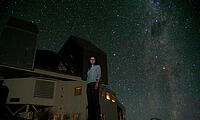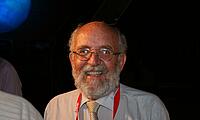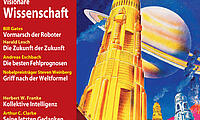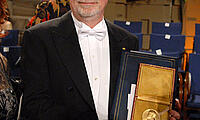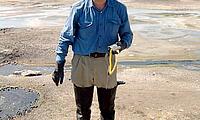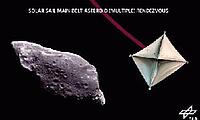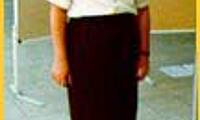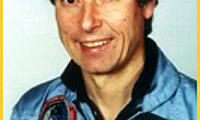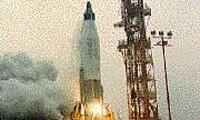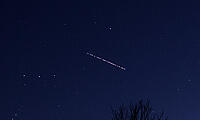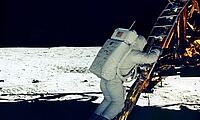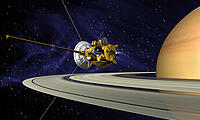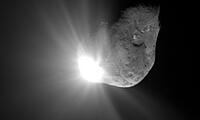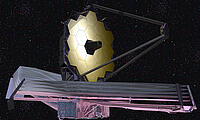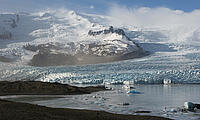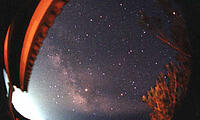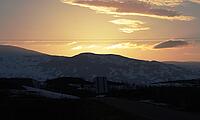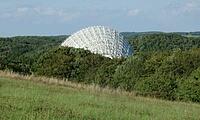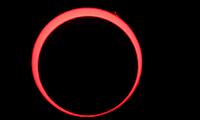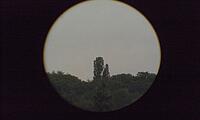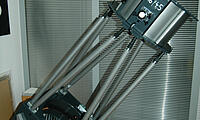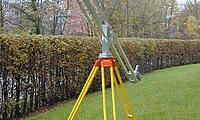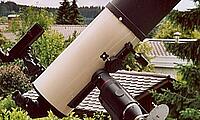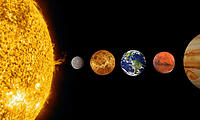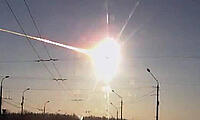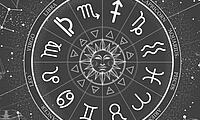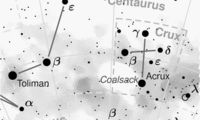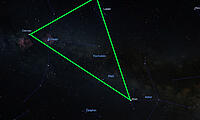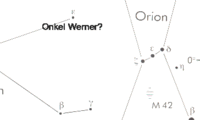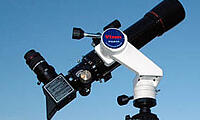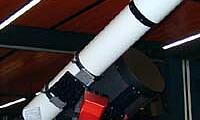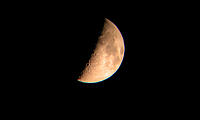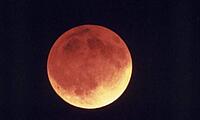We reserve the right to get smarter!
von Dr. Harald Zaun, 2011
H. Zaun: What is the status quo concerning the SETI institute and the Allen Telescope Array?
Jill Tarter: On April 15th this year we had to put the Allen Telescope Array (ATA) into hibernation, because our partners UC Berkeley were unable to finance the operation any longer. Therefore we decided to try a new way of funding the telescope with crowd funding – providing an opportunity for many individuals, perhaps of limited means but great passion, to collectively fund our searches. SETIStars.org is supposed to get donations of any amount – to help get the telescope out of hibernation. We hope to be back on air soon. Then we will start different campaigns to raise more financial support, because SETI on the ATA will be ongoing and in need of continuing support.
H. Zaun: How many people in the USA are really interested in the scientific work of SETI?
Tarter: I think that the interest in SETI is probably getting higher now that exoplanets are so much popular in the news. We understand that there are really interesting other worlds out there.
H. Zaun: Now it looks like that the planet hunters did find several habitable Earth-like-planets candidates!
Tarter: The experts predict that less than 10 to 20 percent of the Kepler exoplanet candidates will turn out to be false positives. So the preliminary catalog of potentially habitable world from the Kepler data release is mostly correct. There is still a lot of work to do but potentially habitable worlds are numerous. There are more data that have not yet been released. So we know that there is good reason to expect that most of these candidates will in fact turn into verified planets when there are enough ground based observations available to conduct the follow-up observations. And of course there will be many more observations to come. But to find an Earth-like planet around a Sun-like Star at a distance of about one Astronomical Unit (AU) requires three transits, and three years – that cannot be achieved, not yet.
H.Zaun: Is it not a little bit paradox that despite the detection of the new worlds and Earth-sized planets SETI right now has to face a financial cut? To my mind it is a very contradictory situation that SETI has to stop its observation right now.
Tarter: It is extraordinary frustrating for us.
H. Zaun: On the other hand you must be motivated to go on further with you work, just because we know now that there are Earth-sized extrasolar planets in habitable zones out there ...
Tarter: Exactly. So in the beginning of this year we started to plan our near-term observing schedule. I am on the Kepler Science Working Group and am privileged to have some early information. We put together a two-year-program to study these Kepler-Worlds with ATA. And we are really excited about to doing that.
In January 2011 we began to observe the Kepler planets that were calculated to be within the habitable zones of their stars – on April 15th we had to take the telescope off the air. It is extremely frustrating – just the wrong thing to do. We are really eager to get the Allen Telescope Array (ATA) out of its hibernation.
H. Zaun: You must feel like being between the devil and the deep blue sea.
Tarter: Yes, it is no fun!
H. Zaun: How many scientists are working at the SETI-Institute right now?
Tarter: It depends on what your assumptions are when you ask that question. Now we have about 130 workers at the SETI Institute, but only a handful of them work with me on SETI – the vast majority of my colleagues work on astrobiology or education and public outreach. However, since our name says 'SETI', hardly anybody understands what an astrobiology powerhouse we are.
H. Zaun: And now they are supposed to finance themselves?
Tarter: No, only five scientists are working directly with me. The rest are astrobiologists and education specialists who are funded by the traditional grant process like NASA etcetera. The SETI Institute is an unusual kind of institution. It is a home for research scientists who actually go out and compete for their own funding with grants they are not paid to teach, there is no tenure – they are scientists who really are passionate about research. I do not think you have many institutions like this in Germany.
H. Zaun: Where do you see the most essential paradigm shift in our field?
Tarter: I see two paradigm shifts. First the new exoplanet worlds I have talked about; since 1995 we know that they are real and not just a good theory. And next: extremophiles. Throughout my career I have been confronted with an amazing explosion of newly discovered, exotic, well-adapted life forms that can survive under extreme conditions nobody had previously imagined. When I was a student I learned the canonical axiom that life needs sunlight. If it is freezing or boiling it may not survive. But now what we are finding is blowing that all away! The latest extremophile appeared only a month ago – a monumental creature from hell. It is a millimeter in size and it lives down very deep in the Earth under extremely high temperatures and pressures.
H. Zaun: But extremophiles are not able to send radio or laser signals – they must reach a higher level ...
Tarter: (laughs) Yes, microbes cannot build transmitters, which is our current, pragmatic definition of intelligence. But it does mean that the real estate out there that could support habitable environments is not as confined as we once thought. And how would these possible extraterrestrial organisms end up being well suited to their extreme conditions through millions of years of evolution? The point is that it might be possible for evolution operating in different environments to produce telescopes and built transmitters like the ones we have – the manufactured technology, based upon physics, might be the same even if the biology is not.
H. Zaun: When will ATA start with new observations? How optimistic are you concerning this point?
Tarter: I am always optimistic. I hope it will happen soon.
H. Zaun: In the recent discussion about cosmological topics you find more religious tendencies like the intelligent design concept or creationism, respectively. In August 2006 the established scientific magazine SCIENCE reports that only 40 percent of the American population really believes in the concept of evolution!
Tarter: Isn't this disgusting? The apparent rise and believe in pseudoscience is very disturbing in our country. In our previous administration we had a faith-based-science. It was really absurd and not science at all. This is very scary for any country that wants to continue to advance.
H. Zaun: You are referring to Mr. George W. Bush
Tarter: Yes, certainly I am referring to him and to his whole administration. In the near, and not so distant, future we'll have huge challenges and we are supposed to solve a lot of technological problems in order to insure the survival of the human species on Earth. If we allow science to be mistaken for pseudoscience and if we allow our politicians to make decisions on the basis of nonsense, then we do not have a bright future.
I am always amazed when I talk to people to find how willing they are to believe absolutely absurd things, just because somebody told them. We have deniers of climate change and deniers of evolution despite the overwhelming preponderance of scientific facts.
H. Zaun: And deniers like dogmatic priests and preachers who have strong influences over the media ...
Tarter: Yes, that is very disconcerting, too. It is not a good way to run a country, and it is not a good way to sustain as an intelligent population. Like it or not, the universe is as it is, independent of what you may choose to believe.
H.Zaun: What to do think about the new options to seek for gravitational waves and neutrinos?
Tarter: Gravitational waves and neutrinos in astronomy are extraordinarily exciting. The point is that I would not try to build such enormously expensive gravitational and neutrino detector arrays like LIGO, LISA and Amanda for the purpose of doing SETI alone. But when they exist we should absolutely be looking at the data to see if there is anything hidden inside that in fact could be an indication for some extraterrestrial astroengineering or signaling projects. Yes, we have already had conversations with the Amanda folks. There have been some papers about certain suggestions of different neutrinos that might look interesting for signaling. Yes, Amanda would be sensitive to some of those suggestions and people will keep their eyes on.
H. Zaun: To my mind it is logical that a very highly developed technology would seize any chance to communicate and therefore use not only the whole electromagnetic spectrum, but also gravitational waves and neutrinos to be successful.
Tarter: Yes, we have to grow up. We have to get smarter. We, the members of the SETI community, always say that we reserve the right to get smarter. We will do what we are doing – we will do it better. And when other, appropriate technologies become accessible – we will use them too.
H. Zaun: What is your personal opinion about scientists who practice Active SETI like the Russian Radio Astronomer Alexander Zaitsev.
Tarter: We are children. We are an emerging technology in very old galaxy. We do not know whether there are other technologies out there. If there are – we know they must be older. I think what we need to do is recognize the asymmetry of our situation. If 'they' exist, they will be older. If they are older it is statistically unlikely that our first contact will also be their first contact. They have done this before for sure. They know how it works. As the youngest kids on the block, we should listen first and learn. When we ourselves have grown old, then we can take on a harder job of transmitting with the fair assumption that perhaps we are the first. I do not think that we should transmit until we have expended an amount of effort that is required to draw the incredible conclusion of our primacy. If we do inevitably get to be an old civilization, if we can manage our population, if we can use technology to stabilize our environment and search diligently for evidence of someone else and do find nothing – then we should start to transmit. And in that case we may have a reason to start discussions about the next question: Who is going to speak for Earth?
H. Zaun: But Seth Shostak wrote in his last (good) book we should send the whole content of the Word-Wide-Web into space.
Tarter: I think that this is an inefficient way to do it. If there were no global consensus about what to do, the internet is certainly like a Rosetta stone – there is enough redundancy that you could probably deduce the syntax and vocabulary incidentally, but I'd love to have the opportunity to find out whether Seth or I am even close to correct. I think you could also probably create a much more efficient message directly, once you decided what it is you want to say. In terms of receiving a signal and whether we would reply, at the SETI Institute we have always maintained that we would not do so unless there was some global consensus that we should. Whenever I said this to Freeman Dyson he has just chuckled. He says to me: "Jill, that is so romantic, and principled. You know that if you ever announced that you detected a signal and say where it is coming from and explain its nature, anybody on the planet who will be able to get their hands on a transmitter will do so. Then everyone will shout their own messages into the cosmos. And then Freeman looks at me with a twinkle in his eye and says: "A great cacophony – would this not be about the best description of our 21century planet that we could send?"
H. Zaun: Do you think the minds of the authorities will be changed when we got contact to another civilization?
Tarter: Well, we have held meetings and asked this question of diplomats, religious leaders, social scientists, media specialists, and other authorities. The best they can tell us is that the world will react to the announcement of the detection of an ETI signal in terms of whatever political and believe systems are ruling in that time. The specific thing I am worried about is whether the source might have a very high or a very low declination, so that there would be an intrinsic geopolitically, north-south, have not tension. In this case some countries will not get access to a territory that could in fact detect a signal. I think that could be a problem unless it is immediately made clear that we will form a global organization to share the information with everyone.
H. Zaun: Did you know that in 1977 two scientists used the German Radio Telescope in Effelsberg and made a short SETI-observation lasting only two hours?
Tarter: Really, they did? I didn't know this. I was there in 1981 and I proposed to do an experiment with one of the relatively local VLBI tape recorders, the Mark 1 at Jodrell Bank in England. At the time there were blank hours on observing schedule of that telescope. Only a few people really used it and there was time between their observing programs. I just said: "I got targets all over the sky and I want to use the Mark 1 and I will observe when no one else has been awarded time on the telescope. My proposal was turned down at first. And then the director of the Max Planck Institute for Radio Astronomy (MPIfR), Peter Mezger, convinced the time allocation committee with the statement: "Do you really want to miss out on the biggest discovery of mankind?" (laughs) And he forced it through. So I was permitted to do it – unfortunately, I couldn't pull it off because the Mark 1 recorder that I had hoped to use could not be made operational. So actually I was never to do the experiment.
H. Zaun: Why European Radio Astronomers are that conservative and skeptical regarding SETI?
Tarter: Attitudes about SETI are perhaps more conservative in Europe. When Seth Shostak was working in Groningen in Netherlands and I showed up during a sabbatical, we applied for observation time on the Westerbork Synthesis Array – and after much wrangling they did give us a total of four hours. Four hours to look at the galactic center, which is might or might not be exactly the place where you want to look as a SETI-Scientist, depending on your model. It was a big struggle. I'm delighted that the LOFAR telescope that is now operating across the Netherlands, Germany, France and the UK has just begun a SETI program to eavesdrop on potential low frequency leakage broadcasts from other technological civilizations.
H. Zaun: Do you think that you will have the opportunity to use the Square Kilometre Array (SKA) for the purposes of SETI some day?
Tarter: I have been involved with SKA since 1996. Sigh ..., some weeks ago we had a meeting of the US-SKA consortium and we decided to dissolve ourselves because the fiscal assessments of the astronomy and astrophysics decadal review in the US foretold that the US would be unable to put any funding into preconstruction or construction of the SKA during the coming decade. We knew that we could not even continue to pay our dues to participate in this global discussion and construction effort. We just dissolved. I am really sad that the US backed out of this collaboration, because many of us had worked on it for a long time and had innovated the technologies needed to build the mid and high frequency components of the SKA. Have a look at the designs for the dishes! They look pretty much like the ATA. So, at least we have had some influence and shared what we have pioneered.
A talk with the Grande Dame of the SETI-Institute in California, the American Astronomer Jill Tarter
The US-Astronomer Jill Tarter is the current director of the Center for SETI Research ( www.seti.org/seti ) at the SETI Institute in California. She holds the Bernard M. Oliver Chair for SETI and is a Fellow of the American Association for the Advancement of Science and the California Academy of Sciences. She was named one of the 100 most influential people in the world by Time Magazine in 2004. Dr. Tarter has been honored with several distinguished awards like the TED Prize in 2009. Her astronomical work was illustrated in Carl Sagan's novel "Contact". In the homonymous movie Tarter was the inspiration for the main protagonist, Ellie Arroway (played by Jodie Foster). Tarter is still traveling around the world and presenting lectures and papers at numerous scientific symposia and colloquia. She talks to the general public as well – just to convince everyone that the scientific search for extraterrestrial intelligence is one of the most important and fascinating scientific challenges in future we must face.
You may find a shorter version, translated into german, here: http://www.heise.de/tp/artikel/35/35351/1.html
The author of this interview would like to express his gratitude to the "Initiative Wissenschaftsjournalismus" for financial support
ETI needs your help as well – mentally, intellectually and financially. Learn more: https://setistars.org/donations/new
Der Autor Dr. Harald Zaun

Harald Zaun (geb. 1962) ist promovierter Historiker und studierter Philosoph mit naturwissenschaftlichem Hintergrund (Universität Köln). Er arbeitet in Köln als freiberuflicher Wissenschaftsautor und Wissenschaftshistoriker und publiziert regelmäßig mit Prof. Dr. Harald Lesch. Der zweifache internationale Bestseller-Autor hat u.a. für die WELT, Süddeutsche Zeitung, Frankfurter Rundschau, Telepolis (Heise-Verlag) u.v.a. geschrieben. Schwerpunkte: Kosmologie, Astrophysik, Raumfahrt, Wissenschaftsgeschichte und primär Astrobiologie-SETI. Sein 2010 erschienenes Buch SETI – Die wissenschaftliche Suche nach außerirdischen Zivilisationen (Heise) wurde von der Max-Planck-Gesellschaft zur Lektüre empfohlen. Sein aktuelles E-Book trägt den Titel First Contact – Spurensuche nach kosmischer Intelligenz und die Gefahren (Heise, 2013). Mitglied der Deutschen Astrobiologische Gesellschaft (DAbG). Sein neues Werk mit Prof. Lesch erscheint 2019 im Bertelsmann-Verlag.
Unser Autor würde sich über einen Besuch seiner privaten Seiten unter www.haraldzaun.de freuen!

